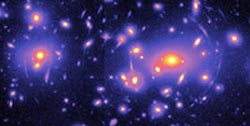Substructure maps show that dark matter clumps in galaxies

Gravitational lensing image of galaxies (yellow to red) and haloes from clumped dark matter (blue)"
Hubble Space Telescope data, analyzed by a Yale astronomer using gravitational lensing techniques, has generated a spatial map demonstrating the clumped substructure of dark matter inside clusters of galaxies.
Clusters of galaxies (about a million, million times the mass of our sun), are typically made up of hundreds of galaxies bound together by gravity. About 90 percent of their mass is dark matter. The rest is ordinary atoms in the form of hot gas and stars.
Although little is known about it, cold dark matter is thought to have structure at all magnitudes. Theoretical models of the clumping properties were derived from detailed, high resolution simulations of the growth of structure in the Universe. Although previous evidence supported the “concordance model” of a Universe mostly composed of cold, dark matter, the predicted substructure had never been detected.
In this study, Yale assistant professor of astronomy and physics Priyamvada Natarajan and her colleagues demonstrate that, at least in the mass range of typical galaxies in clusters, there is an excellent agreement between the observations and theoretical predictions of the concordance model.
Using gravitational lensing made it possible for the observers to visualize light from distant galaxies as it bent around mass in its way. This allowed the researchers to measure light deflections that indicated structural clumps in the dark matter.
“We used an innovative technique to pick up the effect of precisely the clumps which might otherwise be obscured by the presence of more massive structures,” said Natarajan. “When we compared our results with theoretical expectations of the concordance model, we found extremely good agreement, suggesting that the model passes the substructure test for the mass range we are sensitive to with this technique.”
“We think the properties of these clumps hold a key to the nature of dark matter — which is presently unknown,” said Natarajan. “The question remains whether these predictions and observations agree for smaller mass clumps that are as yet undetected.”
Co-author on the study, funded by Yale University, is Volker Springel, MPA, Garching, Germany. Other collaborators include.Jean-Paul Kneib, LAM – OAMP, Marseille, France, Ian Smail, University of Durham, U.K., and Richard Ellis of Caltech.
Media Contact
All latest news from the category: Physics and Astronomy
This area deals with the fundamental laws and building blocks of nature and how they interact, the properties and the behavior of matter, and research into space and time and their structures.
innovations-report provides in-depth reports and articles on subjects such as astrophysics, laser technologies, nuclear, quantum, particle and solid-state physics, nanotechnologies, planetary research and findings (Mars, Venus) and developments related to the Hubble Telescope.
Newest articles

Superradiant atoms could push the boundaries of how precisely time can be measured
Superradiant atoms can help us measure time more precisely than ever. In a new study, researchers from the University of Copenhagen present a new method for measuring the time interval,…

Ion thermoelectric conversion devices for near room temperature
The electrode sheet of the thermoelectric device consists of ionic hydrogel, which is sandwiched between the electrodes to form, and the Prussian blue on the electrode undergoes a redox reaction…

Zap Energy achieves 37-million-degree temperatures in a compact device
New publication reports record electron temperatures for a small-scale, sheared-flow-stabilized Z-pinch fusion device. In the nine decades since humans first produced fusion reactions, only a few fusion technologies have demonstrated…





















